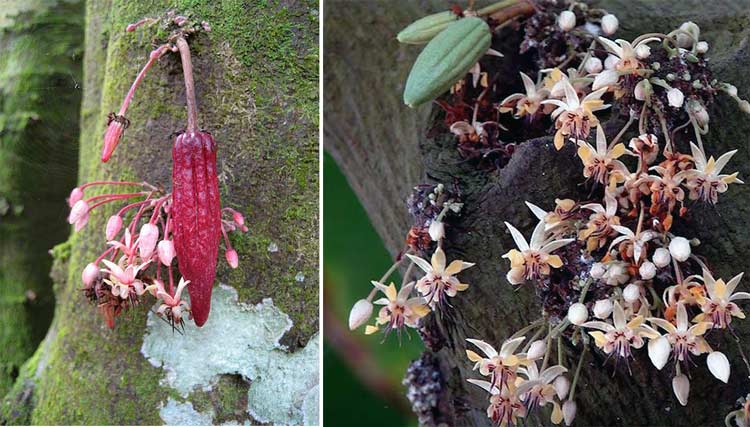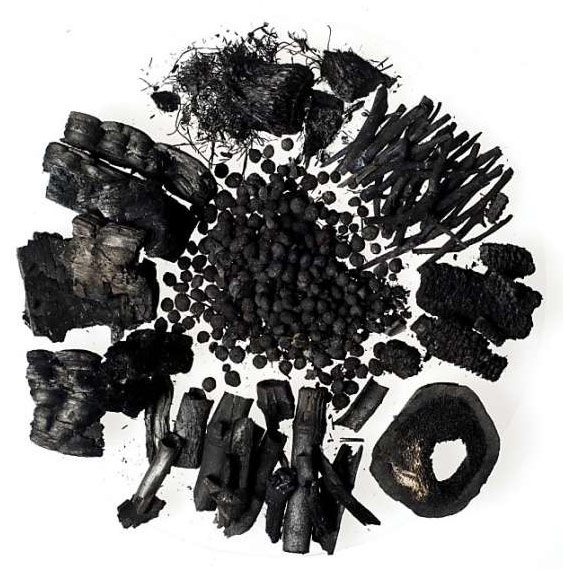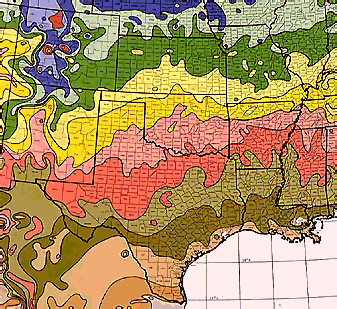My attempts to grow a tropical plant in a non-tropical area are still ongoing… I’m waiting for the promised fresh cocoa beans from the Philippines and arming myself with theory before practice, as I’m planning to grow a cocoa tree in a container at home.
Everything available online on this topic has been carefully studied and laid out below. It’s possible that I’m not the only one who has long dreamed of a cocoa tree in a temperate zone.
What is a cocoa tree like?
A chocolate tree in its natural conditions can grow up to 6 meters tall. The leaves are elongated, delicate, and thin. The trunk is of medium thickness and moderately branched. It bears fruit for up to 60 years and can live up to 100 years.
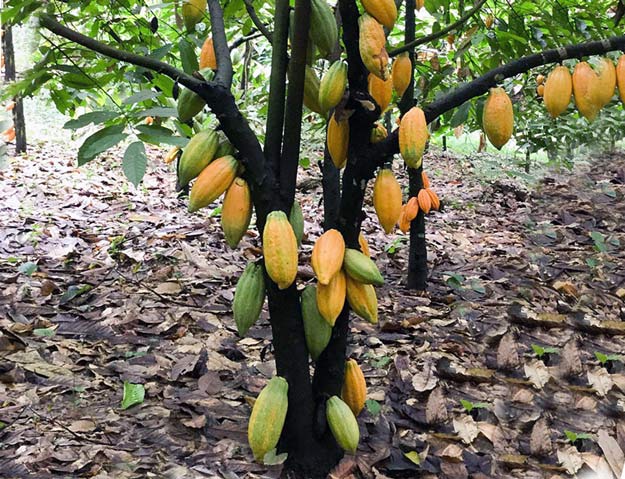 Cocoa grove in the Philippines
Cocoa grove in the Philippines
Cutting or seeds?
If you can get a cocoa tree cutting, that’s excellent. The root system of a tree propagated vegetatively via cuttings always remains compact. When cocoa grows naturally from seeds, its root develops a taproot shape, burrowing deep into the soil. Seedlings grown from seeds cannot develop properly in a container and will require transplanting into a greenhouse after a few years.
 Photo by Jochen Weber, seedling from a cocoa bean
Photo by Jochen Weber, seedling from a cocoa bean
Seeds are viable for planting only a few days after being extracted from the fruit’s pulp. The main challenge in growing cocoa from seeds is obtaining the freshest, still-moist, viable beans. Here, you’ll need to trust the seller, as the cocoa pod will take at least some time to be shipped, often from places like Sri Lanka.
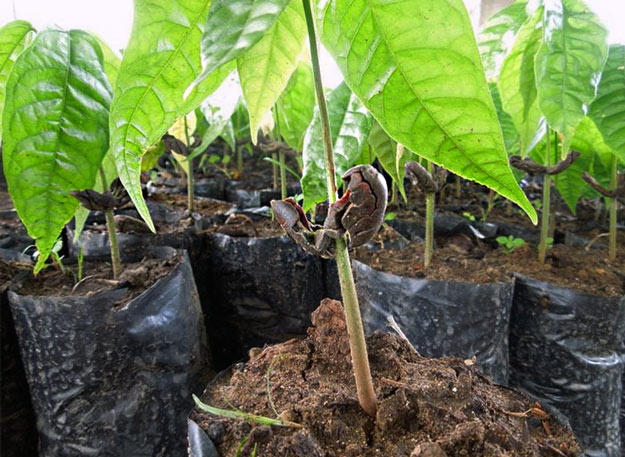 Seedling prepared for a greenhouse transfer in Canada
Seedling prepared for a greenhouse transfer in Canada
Another advantage of a cutting is the buds on the branch. Generally, branches with one or two buds are used for cutting, increasing the chances of harvesting your own cocoa beans.
How much does it all cost?
On eBay, you can buy a good fresh pod for $7-$10, containing no less than 20 cocoa beans, with free shipping. A tree from a cutting, 40–50 cm in height, will cost less than $50, while one grown from seeds will cost $15-$25.
Conditions for growing cocoa
Before plunging into this adventure, let’s figure out the conditions required for the cocoa tree. Considering its tropical roots, it’s not the easiest plant to grow in a temperate climate. Then again, we’ve managed to tame tomatoes…
Cocoa trees originate in areas within 10 degrees north or south of the equator, in a humid tropical climate. Nonetheless, greenhouse conditions with diffused light, a conservatory, or a warm veranda will suit it quite well. Humidity of at least 60%, temperatures between 18 and 32 degrees Celsius, and constant fertilization are the keys to success.
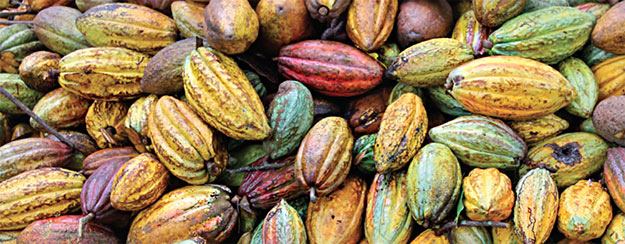 Pods or fruits of the cocoa tree
Pods or fruits of the cocoa tree
There are newer varieties more resistant to moderate climates, but you’ll need to look for them in the market.
Lighting. Cocoa grows in tropical undergrowth, accustomed to diffused light and protection from wind. The midday sun in an open area will scorch the large and delicate leaves of the cocoa tree, which is adapted to capturing every photon missed by its more robust neighbors in the tropics. A grow light during winter should help the plant develop properly.
Humidity. The optimal air humidity is 70%, which can be easily achieved in a greenhouse or a densely populated conservatory. However, in the setting of a winter veranda, a humidifier can help. There’s also a practice of creating an improvised plastic greenhouse in winter, equipped with a humidifier. For a small tree, you can come up with several acceptable methods to maintain humidity during the off-season.
Fertilizer. Cocoa is one of the few trees that constantly needs nutrient-rich fertilizer, particularly high in phosphorus and organic matter. It’s especially “hungry” during the growing season.
Soil. Light, quickly draining soil is a must. Avoiding water stagnation is the main condition for the healthy development of the plant. I will break down all these points in more detail below.
What you’ll need to grow a cocoa tree at home:
- Seeds, cuttings, or seedlings
- Soil
- Compost
- Organic fertilizer
- Plastic film, polyethylene, bags
- Water
- Humidifier
- Grow light with a phyto-lamp
How to grow cocoa from seeds
With fresh beans, there are never issues with germination. It often happens that seeds sprout in the oily, nutrient-rich pulp of the fruit, and upon opening the pod, you may find cocoa sprouts. Incidentally, I know of a woman who harvested her first crop of cocoa beans in a Vermont greenhouse, and her seeds came from New Hampshire. Both are Zone 4 climates, whereas cocoa thrives best in USDA Zones 11–13.
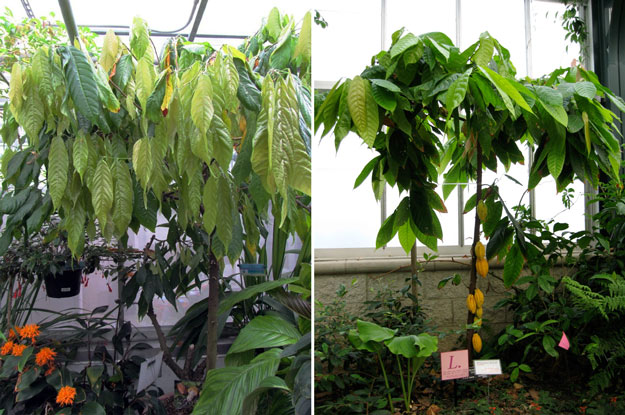
By the way, the coolest greenhouses for studying and breeding cacao trees are located in the suburbs of London. The main task of these British greenhouse-labs is to quarantine seedlings and test new varieties.
 Greenhouse-labs for cacao cultivation and research in England.
Greenhouse-labs for cacao cultivation and research in England.
So, you have a fresh, undamaged pod of yellow, orange, or brown color. Open it very carefully; under the skin lies a slippery, oily pulp. As soon as you open the fruit, immediately proceed to planting—the beans should not be dried.
It’s advisable to gently scarify the seeds to speed up germination. However, you can also skip any manipulations and plant the beans directly in their sweet pulp, as long as you’re prepared to provide them with a moist and warm greenhouse-incubator with a stable temperature (even placing them “under a lamp” will suffice). Careful mold control is important; although, under a lamp, mold usually doesn’t thrive.
You have two planting options: directly in the soil or germinating in a zip-lock bag (or container) using moist cotton wool. The second method delivers quicker and more visible results. Place the seeds in an airtight bag or container lined with damp gauze folded into several layers, or another material that can be easily removed later, keeping the seeds in the dark. Ensure stable temperatures between 24-28°C for the seeds. Once daily, open the bag to air it out and check if a sprout has emerged. As soon as the seed sprouts, transfer it into a pot and place it in a greenhouse with lighting. At this stage, the lighting acts as a heat source, and if you have an electric heating mat, that’s even better.
Fully ripened pods can simply be soaked in warm water overnight after being cleaned of their outer skin.
Planting cacao directly into the soil is straightforward. Use moderately moist, compost-enriched organic soil, being careful not to compact it. Bury the seed no more than 1 cm deep. Soil acidity should range between 4.5-6.5. Mulch the surface. It’s very important that neither the soil nor the pot retains too much water—a “golden balance” is essential. To aid germination, adding coconut coir to the soil is beneficial as it aerates and retains moisture moderately. Perlite and vermiculite up to 10% of the soil volume can also help maintain air and moisture levels in the cacao pot.
There are some planting rules you must not break; I’ve already explained these here .
Growing cacao from a cutting is similar to propagating most shrubs and trees. Both the water method and rooting directly in soil are suitable. It’s unlikely I’ll ever acquire a branch from a cacao tree, but if I do, I’ll root it with honey.
Seedlings should be protected from direct sunlight. In their first 6-12 months, young plants can grow in the shade, after which they require diffused light.
Caring for the Cacao Tree
Seedlings grow very quickly if they enjoy their conditions. In a bright, warm environment, the plant thrives as long as you don’t neglect additional air humidification.
Transplantation will be necessary as the cacao grows. Clay or wooden containers are a better choice than plastic tubs. For mature trees, fertilize with fish emulsion and compost (they require a high phosphorus content). Cacao needs consistent nutrients: starting from the appearance of the first pair of true leaves, feed every 14-21 days, increasing the amount as the tree grows. When the cacao tree reaches 12 to 18 months, it will need about one kilogram of compost monthly (up to two kilograms if transplanted into the ground). From November to February, reduce the amount of fertilizer.
Ground transplantation is only possible in a glass greenhouse where the temperature doesn’t drop below 18°C at night. For 10-12 hours daily, the temperature should not fall below 22-24°C. If you can create these conditions, here are instructions for ground transplantation.
You can transplant a tree that is 60-70 cm tall. The hole for planting should be three times the size of the root ball. Return part of the loosened soil to the hole and place the plant at the same level it occupied in the pot. Fill the hole back in, water well, and mulch. Leave a small, mulch-free circle around the trunk. Provide abundant watering.
Cacao requires pruning. In its first year, a few shoots will develop on the trunk. Remove these shoots, leaving only the strongest ones.
Flowering and Fruiting of the Cacao Tree
The first flowering of cacao should occur in its 3rd or 4th year or when the tree reaches 1.5 meters in height (in natural conditions, the tree can grow up to 6 meters tall). The first flowering doesn’t always result in fruit, even under ideal conditions. For fruiting, cacao doesn’t require a second tree, although some sources claim otherwise. Pollination will have to be done manually, early in the morning, as cacao blooms in the winter. Most of the flowers will wither, which is normal. Protect the cacao tree from powdery mildew and aphids.
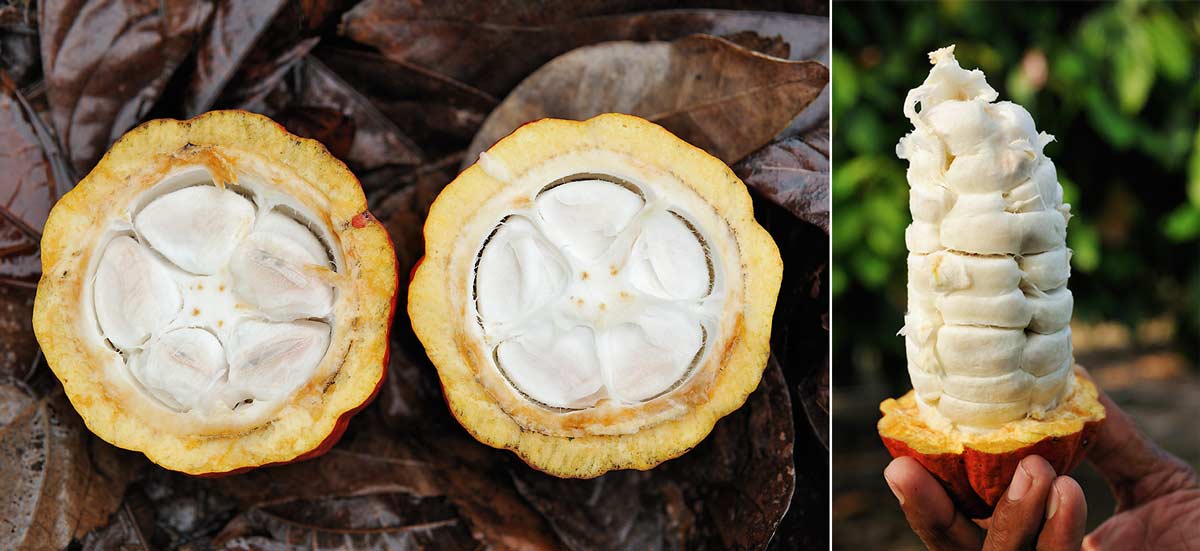 Formation and growth of the fruit take at least six months, usually around 8 months. Harvesting in northern zones occurs in February-March. A healthy, well-maintained young tree can yield 4-5 pods in greenhouse conditions. I think growing cacao is a real challenge for any plant enthusiast. Let’s give it a try!
Formation and growth of the fruit take at least six months, usually around 8 months. Harvesting in northern zones occurs in February-March. A healthy, well-maintained young tree can yield 4-5 pods in greenhouse conditions. I think growing cacao is a real challenge for any plant enthusiast. Let’s give it a try!

